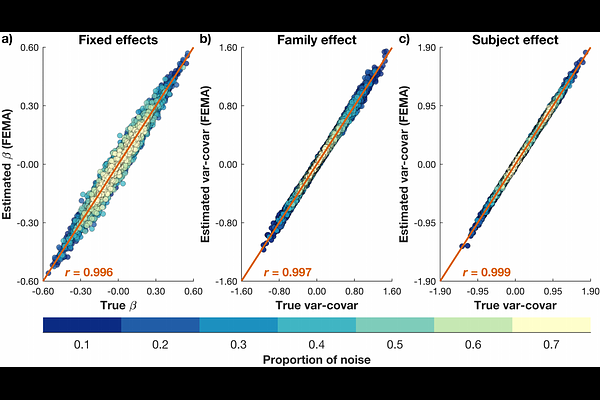FEMA-Long: Modeling unstructured covariances for discovery of time-dependent effects in large-scale longitudinal datasets

FEMA-Long: Modeling unstructured covariances for discovery of time-dependent effects in large-scale longitudinal datasets
Parekh, P.; Parker, N.; Pecheva, D.; Frei, E.; Vaudel, M.; Smith, D. M.; Rigby, A.; Jahołkowski, P.; Sonderby, I. E.; Birkenaes, V.; Bakken, N. R.; Fan, C. C.; Makowski, C.; Kopal, J.; Loughnan, R. J.; Hagler, D. J.; van der Meer, D.; Johansson, S.; Njolstad, P. R.; Jernigan, T. L.; Thompson, W. K.; Frei, O.; Shadrin, A. A.; Nichols, T. E.; Andreassen, O. A.; Dale, A. M.
AbstractLinear mixed-effects (LME) models are commonly used for analyzing longitudinal data. However, most applications of LME models rely on random intercepts or simple, e.g., stationary, covariance. Here, we extend the Fast and Efficient Mixed-Effects Algorithm (FEMA) and present FEMA-Long, a computationally tractable approach to flexibly modeling longitudinal covariance suitable for high-dimensional data. FEMA-Long can i) model unstructured covariance, ii) model non-linear fixed effects using splines, iii) discover time-dependent fixed effects with spline interactions, and iv) perform genome-wide association studies (GWAS) supporting discovery of time-dependent genetic effects. We applied FEMA-Long to perform a longitudinal GWAS with non-linear SNP-by-time interaction on length, weight, and body mass index of 68,273 infants with up to six measurements in the first year of life. We found dynamic patterns of random effects including time-varying heritability and correlations, as well as several genetic variants showing time-dependent effects, highlighting the applicability of FEMA-Long to enable novel discoveries.